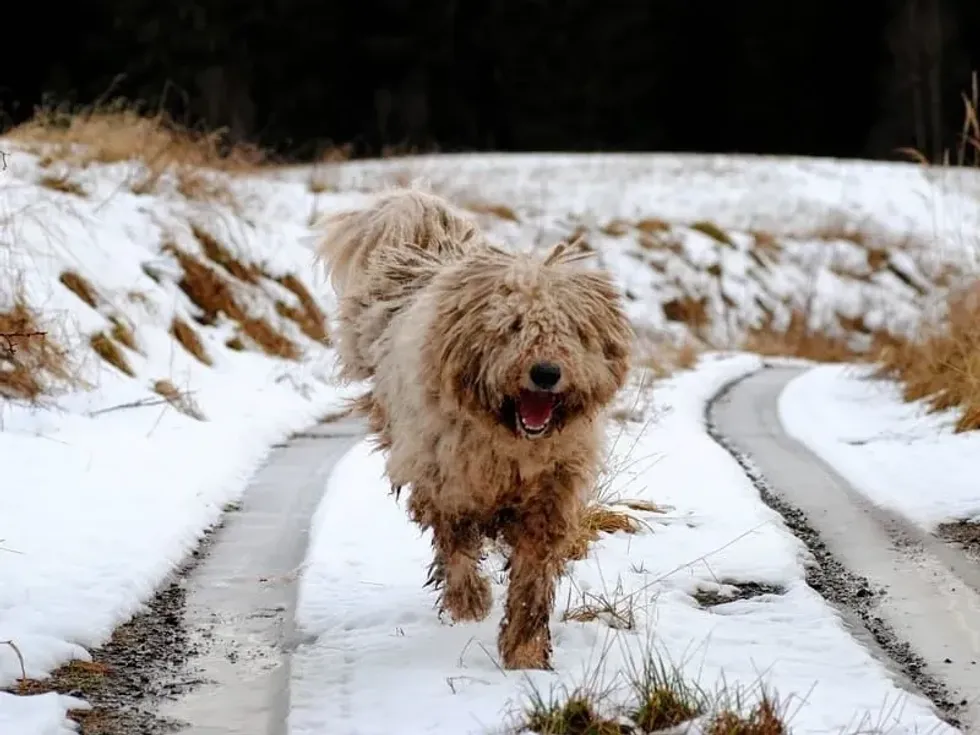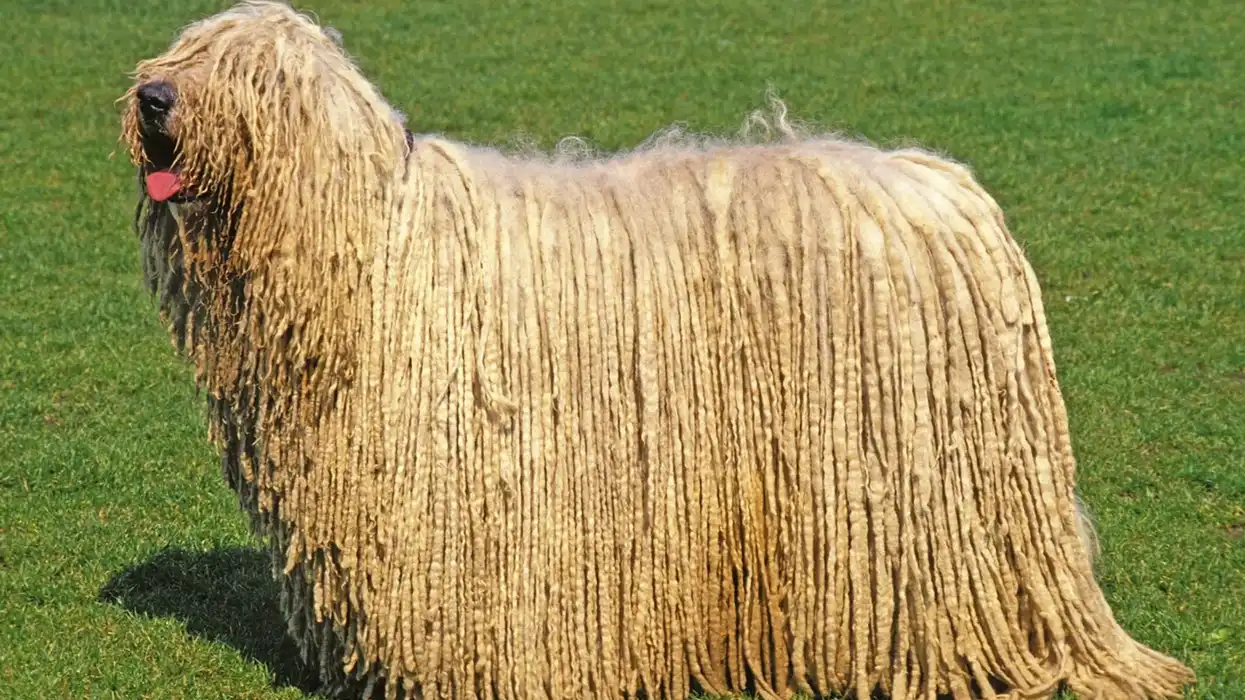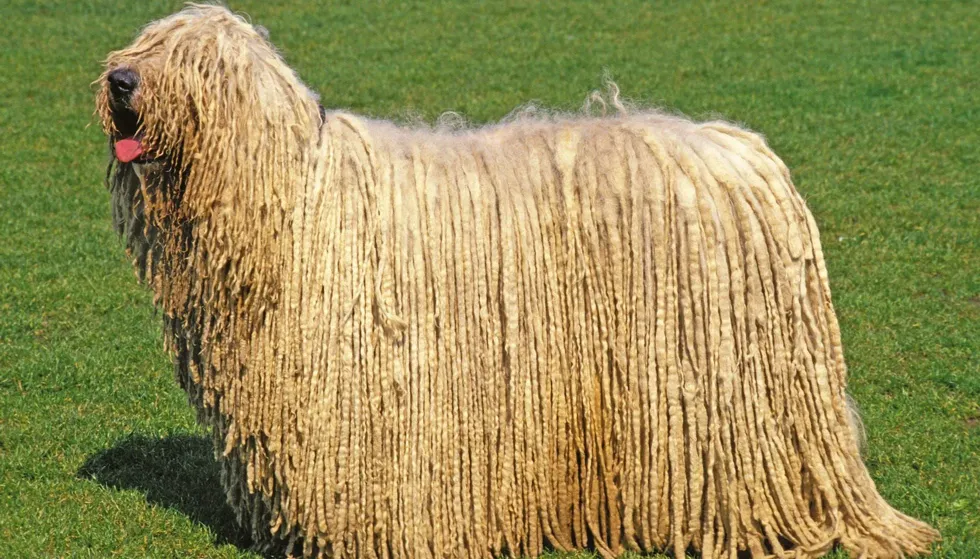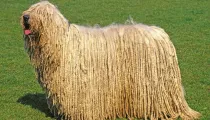Fun Komondor Facts For Kids

The Komondor (plural Komondorok in Hungarian) is a large, muscular livestock guardian dog native to Hungary. It is one of three livestock guard dog breeds native to the country.
This dog has a distinctive white coat with corded hair that resembles dreadlocks or a mop. This allows the dog to blend in well with flocks of sheep while it protects them, lending it an element of surprise.
The Komondor is often referred to as the king of Hungarian flock dogs and is also known as the Hungarian Sheepdog. This working dog breed is extremely loyal, hard-working, and devoted.
Komondorok are strong, agile, and brave dogs that are known to protect and defend livestock and sheep from wolves and other prey. They do not usually herd or round up flocks of sheep but are skilled livestock guardians and protectors.
Their thick corded coats and working personalities make them suitable for living outdoors in farmhouses, farmlands, or in homes with wide fenced yards. They make for great pets and are extremely protective of children and family members.
Read on for Komondor dog facts. For more relatable content, check out these Czechoslovakian Wolfdog facts and wolf facts.
Komondor Interesting Facts
What type of animal is a Komondor?
The Komondor (Canis lupus familiaris) is a large, muscular guard dog belonging to the Canidae family. This dog breed is native to Hungary and is believed to be a descendant of Tibetan sheepdogs and the Caucasian Ovcharka from Russia. The Komondor was bred as a sheepdog in Hungary to protect sheep, cattle, and livestock.
What class of animal does a Komondor belong to?
The Komondor (Canis lupus familiaris) is a sheepdog belonging to the family Canidae and genus Canis in the Mammalia class of the Animalia kingdom.
How many Komondors are there in the world?
The Komondor breed is native to Hungary where it was believed to have been brought by nomadic Magyars or Hungarians to guard sheep and cattle. Recent studies reveal that the Cumans brought Komondors to Hungary. The specific number of Komondors today is not known to us.
Where does a Komondor live?
The Komondor breed is a livestock guardian and is bred to protect cattle and sheep. These large furry dogs are ideally suited for living in cold weather in the countryside in farmhouses to guard sheep and cattle.
However, this large dog breed requires ample space and is not suited for living in apartments in urban areas. The Komondor will do well in a suburban house with a wide fenced yard.
What is a Komondor's habitat?
The Komondor is a working guard dog that was bred in Hungary to protect sheep and cattle in the countryside. The Komondor breed’s habitat is clean country environments, farmlands, and pastures where they are used to protect cattle and livestock.
These dogs have two coats; a woolly undercoat and a thick dreaded or corded outercoat.
Their thick coats keep them warm in cold weather outdoors where they spend a majority of their time guarding their home and property. However, the Komondor does well in most climates and can even live in urban or suburban houses with fenced yards.
Who do Komondors live with?
Komondorok live with families and can be trained and socialized early on to live with other pets such as cats and dogs. As guard dogs, they have a natural protective instinct.
They respond to firm authority and a set of rules that must be taught early on through obedience training. They make for good house pets and guard dogs in both urban and rural areas.
How long does a Komondor live?
The average lifespan of the Komondor dog breed is between 10-12 years.
How do they reproduce?
As Komondor population numbers are small worldwide, these dogs mainly reproduce through ethical breeding. Once Komondor dogs reach sexual maturity at about two to three years of age, they are bred to reproduce.
A male Komondor stud is matched to a female Komondor for mating and breeding purposes. The gestation period for a female Komondor dog is between 63-65 days. The average litter size is between three to ten puppies per litter.
What is their conservation status?
The conservation status of the Komondor breed is Not Listed in any registry. However, this dog breed has been declared as one of Hungary’s national treasures. The Komondor is to be preserved and protected from cross-breeding or any other forms of modification.
Komondor Fun Facts
What do Komondors look like?
The Komondor is a large brawny sheepdog that stands tall with a heavy bone structure, deep chest, and muscular limbs. The dog has a distinctive thick white coat of corded or dreadlocked fur that makes it look like a mop.
The Komondor’s coat has two layers. It has a thick woolly inner coat and a white corded outercoat of heavy dreadlocked hair. The cords of the Komondor’s coat can be anywhere between 8-11 in (20-27 cm).
The Komondor’s body is robust, muscular with long legs and a slightly curled tail. It has a broad head and a short muzzle. The eyes, nose, and lips of the Komondor are all black. As a sheepdog, the Komondor is related to the Caucasian Ovcharka, Puli, Bearded Collie, Polish Lowland Sheepdog, and Old English Sheepdog.

How cute are they?
The Komondorok are extremely cute and adorable. Their thick fluffy white coats with cords of fur make them look like mops! They have deep-set innocent black eyes and cute faces. Their affectionate nature, obedience, and loyalty make them very loving and cute.
How do they communicate?
As with all dogs, the Komondor communicates through a range of vocalizations such as barks, growls, whines, whimpers, howls, and sighs. Komondorok also communicate using sensory information such as scents and pheromones. They also use visual cues such as gaze, the position of the head and ears, movements of the tail, facial expressions, and body postures.
How big is a Komondor?
The Komondor breed is a large muscular dog breed. Males stand tall at about 27.5-31.5 in (70-80 cm) while female Komondorok have a height of about 25.5-27.5 in (65-70 cm). The Komondor is larger than the German shepherd – another popular guard dog counterpart.
How fast can a Komondor run?
Despite its large size and muscular, brawny built, the Komondor is actually quite fast and agile. It is lightfooted and can run quickly.
How much does a Komondor weigh?
Purebred Komondorok are large dogs. The weight of a male Komondor is anywhere between 110-132 lbs (50-60 kg). A female Komondor can weigh between 88-110 lb (40-50 kg).
What are the male and female names of the species?
A male Komondor is called a dog while a female Komondor is called a bitch. A male Komondor used for breeding is called a stud.
What would you call a baby Komondor?
A baby Komondor is called a puppy.
What do they eat?
Komondorok are omnivores and feed on beef and chicken meat, bones, select fruits and vegetables, and quality dog kibble appropriate for their age and developmental stage. In contrast to their large size, Komondorok actually do not require large volumes of food.
This dog breed can survive on up to 2000 calories a day. The Komondor is also known to skip a meal during the day if it is not hungry.
Are they slobbery?
No, the Komondor dog breed is not slobbery. This dog breed sheds very little fur, but it requires high levels of grooming and maintenance.
The cords of the outercoat must not be brushed. They must be dreaded frequently to prevent them from matting and catching dust and dirt. The Komondor can be given a bath to clean its fur.
It must not be bathed too frequently and it takes about two to three days for the corded coat of the Komondor to dry completely. If the coat does not dry completely, it will start to smell unpleasant and lead to skin infections.
Would they make a good pet?
Yes, the Komondor breed makes for a good pet for families. Their guard dog personalities and work ethic make them naturally protective of family members and children.
They are generally calm, stable, and affectionate towards their families. However, they are wary of strangers and can be quite aggressive with other dogs. This is why training is essential from a young age.
You must use praise and positive reinforcement to teach commands and socialize your Komondor puppy to live with and play with children and other household pets. Lack of obedience training and socialization will make your Komondor bored and can lead to destructive or aggressive behaviors.
The Komondor also requires about 40 minutes of physical exercise per day to remain active, healthy, and happy. This dog breed loves to walk and run.
A house with a large fenced yard is ideal for the Komondor to stave off health problems. If given an enriching and stimulating environment, the Komondor makes for an affectionate, loyal, brave, and dignified pet.
Did you know...
The plural of Komondor is Komondorok in Hungarian!
The Komondor dog is also known as the Hungarian Commonmop, Hungarian Sheepdog, or Mop Dog due to its appearance.
Komondorok are descendants of Tibetan sheepdogs. They were brought to Hungary over one thousand years ago by nomadic Hungarians, also known as Magyars.
Among the interesting Komondor breed facts is that if the coat of a Komondor puppy fails to cord by two years of age, it is disqualified from the Komondor dog breed.
Komondorok must have black eyes and a black nose. Blue eyes in dogs lead to disqualification from the breed.
Characteristics and health issues
The Komondor was bred as a livestock guardian dog. It is a working sheepdog native to the plains, pastures, and countryside of Hungary.
It still retains the personality traits and temperament of its working ancestors. The Komondor is loyal, brave, vigilant, and dignified. It is extremely protective of its family and master and will work hard to safeguard family members and property.
The breed was developed to think and act independently in situations of danger to livestock. Thus, it required training to check its aggressive tendencies in the presence of perceived threats. Obedience training and socialization must begin early in the puppy years by a trained behaviorist or dog handler.
When trained and socialized well, Komondorok are extremely affectionate and loyal house pets. This dog's energy level is also manageable.
This dog breed has high maintenance and grooming requirements. Their corded coat must be dreaded frequently to prevent matting and build-up of dirt.
They can be bathed occasionally to clean the fur. You must take care to ensure the fur dries completely over a period of two to three days to avoid any unpleasant smell or infections of the skin.
Getting your own Komondor
The average cost of a Komondor puppy in North America is between $800-$1200 with the average price being $1000. When getting your own Komondor, ensure that your breeder has parent dogs free of hip dysplasia certified by the Orthopaedic Foundation for Animals (OFA). The Komondor Club of America also requires breeders to provide eye health certifications.
Here at Kidadl, we have carefully created lots of interesting family-friendly animal facts for everyone to discover! Learn more about some other mammals from our Shepherd Collie mix facts and Scottish deerhound facts pages.
You can even occupy yourself at home by coloring in one of our free printable Komondor dog coloring pages.
We Want Your Photos!
More for You
See All
Bachelor of Science specializing in Human Anatomy

Joan AgieBachelor of Science specializing in Human Anatomy
With 3+ years of research and content writing experience across several niches, especially on education, technology, and business topics. Joan holds a Bachelor’s degree in Human Anatomy from the Federal University of Technology, Akure, Nigeria, and has worked as a researcher and writer for organizations across Nigeria, the US, the UK, and Germany. Joan enjoys meditation, watching movies, and learning new languages in her free time.
Bachelor of Arts specializing in Economics

Gowri RaoBachelor of Arts specializing in Economics
With a bachelor's degree in Economics from Krea University, Gowri is a highly skilled data analyst and an expert in regression and causation modeling. Her interests in economic trends, finance, and investment research complement her professional expertise. In addition to her professional pursuits, Gowri enjoys swimming, running, and playing the drums, and she is also a talented tutor.
Disclaimer
1) Kidadl is independent and to make our service free to you the reader we are supported by advertising. We hope you love our recommendations for products and services! What we suggest is selected independently by the Kidadl team. If you purchase using the Buy Now button we may earn a small commission. This does not influence our choices. Prices are correct and items are available at the time the article was published but we cannot guarantee that on the time of reading. Please note that Kidadl is a participant in the Amazon Services LLC Associates Program, an affiliate advertising program designed to provide a means for sites to earn advertising fees by advertising and linking to Amazon. We also link to other websites, but are not responsible for their content.
2) At Kidadl, we strive to recommend the very best activities and events. We will always aim to give you accurate information at the date of publication - however, information does change, so it’s important you do your own research, double-check and make the decision that is right for your family. We recognise that not all activities and ideas are appropriate for all children and families or in all circumstances. Our recommended activities are based on age but these are a guide. We recommend that these ideas are used as inspiration, that ideas are undertaken with appropriate adult supervision, and that each adult uses their own discretion and knowledge of their children to consider the safety and suitability. Kidadl cannot accept liability for the execution of these ideas, and parental supervision is advised at all times, as safety is paramount. Anyone using the information provided by Kidadl does so at their own risk and we can not accept liability if things go wrong.
3) Because we are an educational resource, we have quotes and facts about a range of historical and modern figures. We do not endorse the actions of or rhetoric of all the people included in these collections, but we think they are important for growing minds to learn about under the guidance of parents or guardians.







